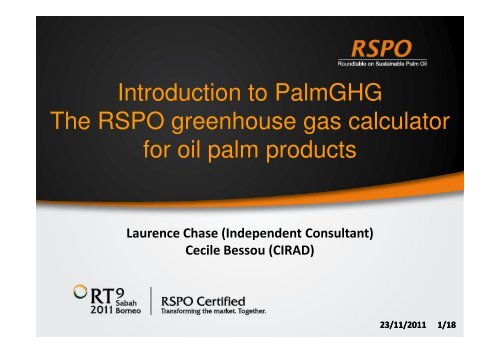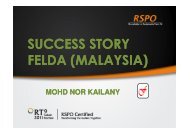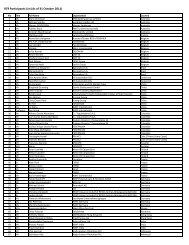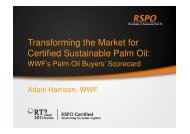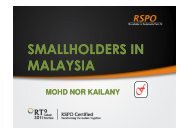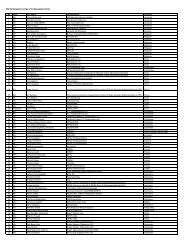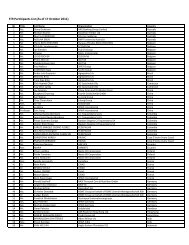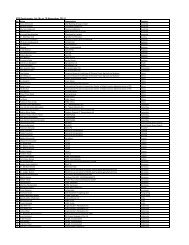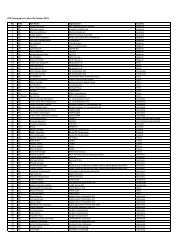Introduction to PalmGHG The RSPO greenhouse gas ... - RT9 2011
Introduction to PalmGHG The RSPO greenhouse gas ... - RT9 2011
Introduction to PalmGHG The RSPO greenhouse gas ... - RT9 2011
You also want an ePaper? Increase the reach of your titles
YUMPU automatically turns print PDFs into web optimized ePapers that Google loves.
<strong>Introduction</strong> <strong>to</strong> <strong>PalmGHG</strong><br />
<strong>The</strong> <strong>RSPO</strong> <strong>greenhouse</strong> <strong>gas</strong> calcula<strong>to</strong>r<br />
for oil palm products<br />
Laurence Chase (Independent Consultant)<br />
Cecile Bessou (CIRAD)<br />
23/11/<strong>2011</strong> 1/18
Workstream 1<br />
Measuring, moni<strong>to</strong>ring & reporting operational GHG<br />
emissions<br />
Amir Faizal Naidu Abdul-Manan, fuels scientist, Shell Global Solutions Sdn. Bhd.<br />
Cécile Bessou (lead author), Ph.D., researcher at CIRAD<br />
Jean-Pierre Caliman, Ph.D., producer, Direc<strong>to</strong>r of the SMART-Research Institute<br />
Laurence Chase, MSc., Independent Consultant in Tropical Agriculture<br />
Sau Soon Chen, Assoc. Prof. Ph.D., SIRIM Environmental & Bioprocess Technology Centre<br />
Shabbir Gheewala, Prof. Ph.D., researcher at the Joint Graduate School of Energy and<br />
Environment, King Mongkut’s University of Technology<br />
Ian E. Henson, Ph.D., Independent Consultant in Tropical Agriculture<br />
Simon Lord, Ph.D., producer, Group Direc<strong>to</strong>r of Sustainability, New Britain Palm Oil<br />
Llorenç Mila-i-Canals, Ph.D., researcher at Unilever R&D<br />
Pavithra Ramani, Project manager in agricultural commodities, with focus in the palm oil and<br />
biofuel sec<strong>to</strong>rs at Proforest<br />
Bambang H. Saharjo, Prof. Ph.D., consultant for Sawit Watch, NGO<br />
Mukesh Sharma, Ph.D., producer, Head of R&D at the Asian Agri Group<br />
Adrian Suhar<strong>to</strong>, producer, Sustainability Manager, Neste Oil Singapore Pte Ltd<br />
23/11/<strong>2011</strong> 2/18
<strong>PalmGHG</strong><br />
Palm products <strong>greenhouse</strong> <strong>gas</strong> accounting <strong>to</strong>ol<br />
23/11/<strong>2011</strong> 3/18
<strong>PalmGHG</strong><br />
A calcula<strong>to</strong>r that quantifies the major forms of GHG emissions<br />
and C sequestration from a mill and its supply base (estate and<br />
out-growers)<br />
It is based on a harmonized framework that is compatible with<br />
international GHG accounting methodologies (IPCC, ISCC, etc.)<br />
<strong>The</strong> content of the calcula<strong>to</strong>r and the features of the <strong>to</strong>ol have<br />
been discussed within the whole GHG Working Group 2<br />
23/11/<strong>2011</strong> 4/18
System boundary<br />
23/11/<strong>2011</strong> 5/18
Important features<br />
a) Flexibility:<br />
I. Adoption of different crop rotation lengths and possible choice of<br />
oil palm growth data<br />
II. It allows use of alternatives <strong>to</strong> the standard defaults<br />
III.<br />
It allows for the calculation of GHG for CPO, PKO and bio-diesel (<strong>to</strong><br />
be compatible with the European Renewable Energy Directive<br />
requirements)<br />
b) It caters for CO 2 emissions from land use change and peat soils<br />
management<br />
c) It allocates <strong>to</strong>tal net emissions between co-products<br />
d) It calculates annual net emissions per ha and per <strong>to</strong>nne of palm product;<br />
may be updated yearly<br />
e) It allows for scenario testing<br />
23/11/<strong>2011</strong> 6/18
<strong>PalmGHG</strong> pilot<br />
Presentation of the pilot testing<br />
Objectives of the pilot<br />
⇒ To allow growers <strong>to</strong> experiment with the <strong>to</strong>ol: how can it be<br />
used and what can it be used for?<br />
⇒ To test the consistency of the calcula<strong>to</strong>r: are all needed data<br />
available?<br />
⇒ To gather feedback from users <strong>to</strong> outline improvement needs<br />
and development priorities<br />
23/11/<strong>2011</strong> 7/18
Overview of pilot results<br />
Mills<br />
Mean<br />
tFFB/ha<br />
Outgrowers<br />
included<br />
Peat<br />
soils<br />
Previous land use<br />
A1 23 no no shrub 0.05<br />
A2 24 no no shrub -0.07<br />
B 26 no no cocoa, oil palm 0.79<br />
C1 23 yes 25% grassland, shrub 0.73<br />
C2 19 yes 80% grassland, shrub 2.46<br />
F 19 no no logged forest, oil palm 1.85<br />
G 26 yes no wide range from logged<br />
forest <strong>to</strong> arable crops<br />
tCO2e/tCPO<br />
1.15<br />
H 17 yes no logged forest 1.35<br />
23/11/<strong>2011</strong> 8/18
Net emissions for pilot mills<br />
A1<br />
0.05<br />
A2<br />
-0.07<br />
B<br />
0.79<br />
Pilot companies<br />
C1<br />
C2<br />
F<br />
0.73<br />
1.85<br />
2.46<br />
G<br />
1.15<br />
H<br />
1.35<br />
t CO2e/t CPO<br />
-0.5 0 0.5 1 1.5 2 2.5 3<br />
23/11/<strong>2011</strong> 9/18
Pilot results:<br />
Example of mill C1 base case<br />
2<br />
1.5<br />
t CO2e/tCPO<br />
1<br />
0.5<br />
0<br />
-0.5<br />
26%<br />
14%<br />
Land<br />
Clearing<br />
43%<br />
52%<br />
28%<br />
0.78<br />
0%<br />
12%<br />
8% 9%<br />
5% 2%<br />
-1<br />
1%<br />
-1.12<br />
0.02<br />
Peat CH4 Mill Fuel N2O Ferti. Field Fuel Elec. Seq. Net Em.<br />
-1<br />
-1.5<br />
Estate<br />
Out-growers<br />
-2<br />
23/11/<strong>2011</strong> 10/18
Pilot mill C1:<br />
Combining estate & outgrowers<br />
1.20<br />
1.00<br />
0.91<br />
0.96<br />
0.80<br />
0.73<br />
+/- 25%<br />
+32%<br />
tCO2e/tCPO<br />
0.60<br />
0.55<br />
- 60%<br />
0.40<br />
0.30<br />
0.26<br />
0.30<br />
0.20<br />
0.00<br />
Base case Grassland Shrub Flaring of<br />
bio<strong>gas</strong><br />
Electricity<br />
from bio<strong>gas</strong><br />
Low peat<br />
emissions<br />
(10 t/ha/yr)<br />
High Peat<br />
emissions<br />
(30 t/ha/yr)<br />
23/11/<strong>2011</strong> 11/18
Pilot mill G:<br />
Base case<br />
2.00<br />
63.8%<br />
1.50<br />
1.15<br />
t CO2e/t CPO<br />
1.00<br />
0.50<br />
0.00<br />
-0.50<br />
Land<br />
Clearing<br />
25.6%<br />
2.2% 0.4%<br />
3.4% 3.6% 1.0% 0% -1.64<br />
Peat CH4 Mill Fuel N2O Ferti. Field<br />
Fuel<br />
Elec. Seq. Net Em.<br />
-1.00<br />
-1.50<br />
-2.00<br />
23/11/<strong>2011</strong> 12/18
Pilot mill G:<br />
Capture and flare methane<br />
23/11/<strong>2011</strong> 13/18
Pilot mill G:<br />
Capture methane and convert in<strong>to</strong> electricity<br />
23/11/<strong>2011</strong> 14/18
Pilot Mill G:<br />
100% replant, capture CH4 and convert in<strong>to</strong> electricity,<br />
reduced outgrower sequestration by 10%<br />
23/11/<strong>2011</strong> 15/18
Scenario testing<br />
Base case 1: mixed previous land uses, peat 3%, no POME<br />
treatment, OER 20.8%, estate 20.2tFFB/ha, outgrowers 14.2tFFB/ha<br />
5.09<br />
Net emissions<br />
tCO2e/tCPOtCPO<br />
1.58<br />
0.71<br />
0.27<br />
0.24<br />
-0.62<br />
1 2 3 4 5 6<br />
23/11/<strong>2011</strong> 16/18
Scenario testing<br />
Base case 1: mixed previous land uses, peat 3%, no POME<br />
treatment, OER 20.8%, estate 20.2tFFB/ha, outgrowers 14.2tFFB/ha<br />
1.58<br />
Net emissions<br />
tCO2e/tCPOtCPO<br />
0.71<br />
0.27<br />
0.24<br />
-0.62<br />
1 2 3 5 6<br />
23/11/<strong>2011</strong> 17/18
<strong>PalmGHG</strong> development<br />
After Pilot Phase<br />
⇒ Update C s<strong>to</strong>ck values and peat emission fac<strong>to</strong>rs from WS3<br />
⇒ Incorporate biofuel calculations for potential<br />
compliance with RED<br />
⇒ Peer review of <strong>PalmGHG</strong><br />
⇒ Post-review development - user friendly, manual<br />
23/11/<strong>2011</strong> 18/18
Thank you<br />
23/11/<strong>2011</strong> 19/18


